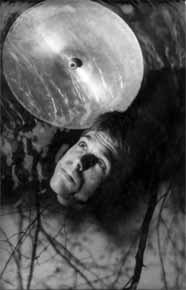 Gerry Hemingway - Multimedia Work
Gerry Hemingway - Multimedia Work Gerry Hemingway - Multimedia Work
Gerry Hemingway - Multimedia Work
Information regarding the DVD release of my film "kernelings" is here.
A YouTube channel on my collaboration with Beth Warshafsky here.
"Behaviors" Solo Performance in collaboration with Visual Artist Beth Warshafsky
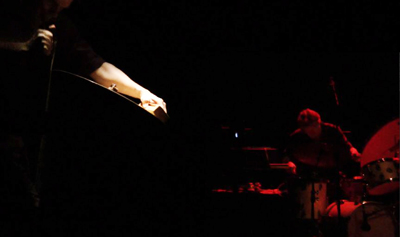
Behaviors is an evolving program of solo acoustic and electronic works which include interactive and formal non-interactive formats with long-time video artist collaborator, Beth Warshafsky. The program presents a mutually conceived visual music that explores the multiple logics of actions and reactions. As part of the process of creating a syntax for this exchange, human and biological behaviors serve as models for perceivable relationships between these two art forms.
Behaviors 1 "Solo for Cymbal" (Performance)
A collaboration of Gerry Hemingway (composer/performer) & Beth Warshafsky (visual artist)
This work for solo cymbal has been evolving as a stand alone musical work for suspended cymbal since the mid-eighties. It began with my interest to explore single parts of my basic drum set configuration, in order to further plumb the expressive potential of each instrument with the use of a diverse array of extended techniques. "Solo for Cymbal" is focused on a sustained landscape of cymbal harmonics generated primarily from bowing the cymbal with a bow designed normally for contrabass. In the version performed in this video the bowed cymbal is accompanied by a pre-recorded signal processing of the same cymbal (also bowed) which is faded in and out in real time by a volume pedal. The cymbal is also amplified to accentuate the rich subharmonics and subtle interplay of the changing harmonic spectrum elicited from the bow and other manipulations which filter and isolate various harmonics.
In October of 2010 I had an opportunity to present a solo program as part of the Follow the Sound Festival in Antwerp, Belgium. I titled the hour long program "Behaviors" and it began with the piece you see here. I asked Beth Warshafsky to develop a single screen piece based on a previous performance of the piece as although there is always variation in the order of the elements and natural evolution of the material in performance, it also somewhat consistent in its nature and form. Beth and I discussed imagery, in particular the notion of the three dimensional cube which begins the work, that allows light to escape around its edges like a solar eclipse, which to me proposed a visual analog to the aural content to the beginning of the work. We also filmed the work in a studio to capture some of the gestural content of the performance which is also a part of the content employed in Beth's visual work.
This particular performance is extracted from the 2011 Nuit Blanche/Guelph International Jazz Festival, where the entire "Behaviors" piece was performed. It montages the performance of the 'Piece for Solo Cymbal' with the single screen video to offer a more dynamic experience of both the performance and the visual content and the way in which they are interwoven.
Behaviors 2 "For Rashied" November 25, 2013 Roulette, Brooklyn, NY
A collaboration of Gerry Hemingway (composer/performer) & Beth Warshafsky (visual artist)
This work was originally presented at the Stone in NYC as the opening to an evening length solo concert that was to become the forerunner for the extended work "Behaviors". It was at a point in my life where I was preparing for a dramatic change of life, expatriating from the US, where I was born had lived my whole life, to Switzerland. The notion of transition played a role in this work which evolved initially out my processing the untimely departure of one of my instrument's central inspirations, the master drummer, Rashied Ali. His sudden death and the reflection to me of just how much his energy and expressive power had opened a huge door for me as an aspiring artist, was somehow aligned with the unknowns I was facing in transitioning to a new life in a different culture and language. Consequently the source content for the electro-acoustic material of the work is drawn in part from sounds recorded from the Swiss landscape as well as a recording of Rashied Ali soloing during a duet with John Coltrane. Each of these threads of recorded material were processed and reconfigured into a slow crescendo that suggests to me different sonic altitudes ranging from high and ethereal to volcanic and subterranean. The acoustic performance which keeps a fast quicksilver pace, starts feathery and transparent and evolves into dense, violent and relentless drumming with the electroacoustic material's envelope (volume shape) controlled in real time by a volume pedal; sometimes it is difficult to discern which is which.
In October of 2010 I had an opportunity to present a solo program as part of the Follow the Sound Festival in Antwerp, Belgium. I titled the hour long program "Behaviors" and it's last section is the piece you see here (posted above is a later performance from 2016 in Auckland, NZ). I asked Beth Warshafsky to develop a single screen piece based on a recording of a performance from the piece's premiere at the Stone in 2009. The form of the piece is somewhat dictated by the prerecorded material, which is a fixed element that the improvised drumming interacts with. However what is heard of the pre-recorded element in each performance is different depending on what I chose in the moment to turn up and down with the pedal so there can be considerable variation from performance to performance.
The visual element follows a similar construction to the electroacoustic material weaving a variety of layered elements including the three dimensional cube from Part 1, various intuitively chosen natural landscapes as well as the processing and layering of visual details of the energetic movement that brings attention to the gestural language inherent in my playing. In this version there is no interactive element between the performance and the projected video, more this work plays with fixed material and freely flowing reactive improvisation.
This particular version is taken from a performance at Roulette on November 25, 2013, Brooklyn, NY .
"Calling You" November 25, 2013 Roulette, Brooklyn, NY (sometimes included in "Behaviors" program)
Calling You (1 of 2) from BSKY on Vimeo.
A work in progress from the collaboration of Gerry Hemingway (composer/performer) & Beth Warshafsky (visual artist)
"Calling you" is presented here as a representation of a collaborative work in continual progress and evolution. The music from the work is an excerpt from an evening length work that developed through several incarnations. The original idea for the work was a from a series of theatrical vignettes I created called "Radio Show". The notion was to create an interaction between my playing and various historical moments in time that reflect the affect radio had on it's listeners when it was the primary dissemination of information and culture. In this vignette I processed the tin pan alley song, "When Im Calling you" as performed by Slim Whitman from a deteriorated cassette recording recorded originally from a radio broadcast on a car radio. I further disintegrated the recording through various granular processes and as is typical of interaction with "taped" audio material while drumming, I control the envelope of the material through manipulating the volume from a volume pedal as I play.
Beth Warshafsky proposed that we use this piece as a vehicle for experimenting with a Max/Jitter interactive set up, where my prerecorded audio (again with volume controlled in real time) would control one visual layer, the dynamic density of my acoustic performance would control another layer of visual material. Beth herself would then control additional layers, one of which was a visual process of me performing in real time, and she would also mix and change these variables through various processing algorhythms and physical controllers she designed for the Max/Jitter interface.
This performance is adapted from a video documentation of the Behaviors 2 performance from the November 23, 2013 performance at Roulette in Brookyln, NY.
Klangtisch 2 - Orange (NYC) - Gerry Hemingway & Beth Warshafsky collaboration (January 2013)
Klangtisch - Live Sound & Image Duet performance at Roulette, November 25th 2013
Above is a more recent work utilizing the Max/Jitter interactive set-up that has been evolving since the "Calling you" piece. This work was first presented on the Kleintheater Performance in Luzern on December 18, 2012. The "Orange" performance was done about a month later in Beth's studio. And following that a performance in November 2013 in NY at Roulette.
Sound Geometries (2016 - ongoing)
SoundGeometries - Performance at The Cell from BSKY on Vimeo.
“Sound Geometries” is seen here in its second realization from a performance on November 29th at the Cell (Chelsea area of New York City).
Beth is projecting images that layer live processing of the performance with an array of visual materials that were developed through discussion and experimentation. This process mirrors the electro-acoustic content of the music. All the visual art is dynamically manipulated through a variety of controllers (including the music itself) in real time.
I perform on the drums while utilizing electronics which incorporate composed sound material, real-time manipulation of that material,and live electro-acoustic processing. This performance also incorporates the spoken word along with visual text. My improvisation is shaped by my response to the live visual material.
The last 6 minutes of this piece is sub-titled "Calling You." It incoporates lyrical narrative material including the sampling of a song by Slim Whitman (see other version above).
In this documentary realization the projected imagery of an overhead screen is interwoven with the documentary footage of the performance.
"Translucent Borders" an interactive performance of sound & image
The first showing of new work in our ongoing by now 30 year collaboration at the VideoEx Festival in Zürich, Switzerland on May 25, 2022. To posit borders and their dissolution, both real and imagined, binary, multi-faceted and shifting, is part of these times in both terrible and wonderful ways. In improvisation, the forms found between the ear and eye are amplified in the bodies of the artist and the experience of the audience in abstract, lyrical and concrete ways. Beth & Gerry’s performance explores the dynamic borders of considered imagery and intuitive texture, spoken and visualized text, acoustic and sampled sound materials as well as real-time performed and projected movement.
The Visiting Tank (1999/2010) several excerpts - not the complete piece
A work for string quartet and sampler with a film video created by Beth Warshafsky
'The Visiting Tank' was composed as part of a program of Chamber Works, originally performed and recorded for Tzadik Records in 1999. It was around that time that the war in former Yugoslavia had left it's legacy of destruction and devastated so many lives.
I composed this piece in a kind of narrative format, imagining, in sound, a story about the war from the perspective of the children who survived it. The visuals were "scored" to the sound through subjective layering of abstract and figurative textures and images.
Presented here are several excerpts from different sections of the work.
additional work with Beth Warshafsky.....
Springs Haiku Soundtrack/Collaboration for Video (01/05) (see video)
Bird Dance Soundtrack/Collaboration for Video (12/04) (see video)
Anthrobits Soundtrack/Collaboration for Video (06/04) (see video)
Ladders Soundtrack/Collaboration for Video (12/03)
Salute Soundtrack/Collaboration for Video (8/98) (see video)
Timing Soundtrack/Collaboration for Video (11/97)
War Soundtrack/Collaboration for Video (2/97)
SHHH Soundtrack/Collaboration for Video (10/96)
Regeneration Soundtrack/Collaboration for Video (8/96) (see video)
Telematic Work
Inspiraling: Telematic Jazz Explorations
Composers - Mark Dresser, Gerry Hemingway, Oliver Lake, Sarah Weaver
San Diego Performers - Hafez Modirzadeh, saxophone, Michael Dessen, trombone, Alex Cline, percussion, Mark Dresser, contrabass
New York Performers - Amir ElSaffar, trumpet, Oliver Lake, saxophone, Min Xiao-Fen, pipa, Gerry Hemingway, percussion, Sarah Weaver, conductor
Coordinators - Mark Dresser and Sarah Weaver
In June 2010 I participated as one of four composers in contributing a piece for a double quartet in two separate locations (NY/San Diego) connected through the telematic music medium. Telematic music is real-time performance via the internet by musicians in different geographic locations playing together as one trans-continental ensemble in real-time and "real-space".
My work for this event was entitled "OilEye"
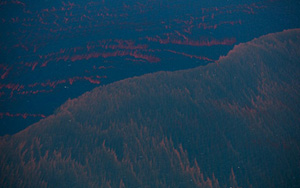
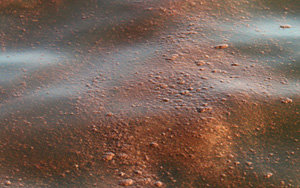
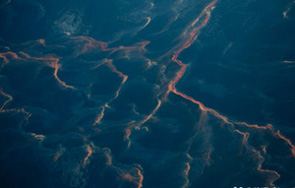
The process of creating this work was several-fold. Initially I began with an investigation of the performance realities of the telematic technology by asking musicians who had experience performing with it, exactly what I could expect as far as synchrony was concerned. A general consensus was that I would experience about a .25 second delay in audio, and about a .50 or more delay in video stream. I was intrigued by this slight difference in timing as a musical device. I could imagine a few musical ideas being affected positively by this inherent delay, and I was also intrigued with how the West coast quartet would sound to us on the East Coast if they were reacting to Sarah Weaver’s East Coast visual conducting of pulse (an interesting, less calculable, exponentiation of this delay issue).
But then, as is sometimes the case when one begins a process from an abstract position, an unexpected element you encounter enters the equation that ends up clearly shaping the decisions and orientation of the compositional process. What I encountered, in the middle of working on this music, was an email from a nature conservancy containing some painful documentation of the Gulf Oil disaster, which was reaching a disastrous crescendo in May of 2010. Here mankind was steadily losing a battle with containing a seemingly unstoppable ejaculation from deep inside the earth, of a resource that has prompted a legacy of greed, war, manipulation of need and erosion of our most fundamental life-sustenance, water and air. Oil and water, we are shown and told when we are kids, don’t mix, (because the intermolecular bonds in both are so strong) but I know I was one of many dazzled by the amazing colors that emerge from the chemical reaction of this combination. This, along with the many dichotemies unfolding in this disaster, struck me as very in keeping with the structure of the musical content I was already working with in this piece. For instance I was already exploring the issue of illusory synchronicity, where the actualization of the material conveys a unified perspective but actually it is a tenuous connection affected by the technology and its limitations. This seemed a poetic parallel to portraying the way in which the oil and water and all of the related metaphors of the disaster were coexisting yet separate.
A DVD soon to be published of the entire concert will eventually be available for you to see the whole concert. For now there is an excerpt of the piece you can view here:
"Three Stories" for Telematic Sextet, spoken word and film (2013)
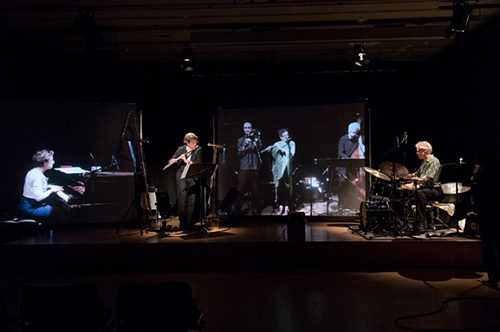
This work, specifically designed for the Telematic medium of performance, and for the distinct players who will be performing the work this evening, is focused on various relationships of narrative to music and form. The work is structured into eight consecutive sections beginning with a prologue, followed by a short story which is read aloud by one of the musicians followed by an instrumental piece of roughly the same length. This read aloud story followed by an instrumental piece is repeated 2 more times and the composition concludes with an epilogue.
For the prologue and epilogue I have created two short films which serve as the main focal point in these sections. The music and the film combined creates a setting, a sense of place, as well as a visual and auditory reflection of the underlying themes of the stories. After the prologue, the first story is read (in this case by Myra Melford) and after each spoken sentence the story is continued by an improvised musical "sentence" from an instrumentalist, in this case Michael Dessen on trombone. The other four players improvise a musical background (like a soundtrack) to the foreground of the story.
This then transitions into the first of three musical pieces which are intended to function in a more abstract way as stories unto themselves, perhaps reflecting the previous story or telling another. The musical pieces are also constructed in a kind of classical sequencing of tempo (adagio, largo, presto) and utilize a polyrhythmic base over which various forms melodic exposition are employed. In designing the piece in consideration of the technical characteristics of this medium, I always instrumentally paired one of three functions that are in each section. First there is the pulse - meaning the material which everything else that is written relates to, is played first by two musicians "locally". In the first piece that is myself and Matthias Ziegler. Then a polythythmic layer is added, and then the melodic or linear material is added to this rhythmic base.
So that you can follow who is doing what as the piece progresses, the second story is read by myself and the instrumentalist who I alternate sentences with is Matthias Ziegler. This is followed by the 2nd instrumental piece. The third story is read by Nicolle Mitchell, and the instrumentalist is Mark Dresser and this story is followed by another instrumental piece. Then a second film appears under which the musicians perform the epilogue music.
The work is in homage to the filmmaker, photographer, and writer Chris Marker, who is most well known for his 1962 film, La Jetée. His sensibility about memory, time and place has been highly influential to my work.
More information about the DVD release is available here.
Previous Solo Work with Multimedia:
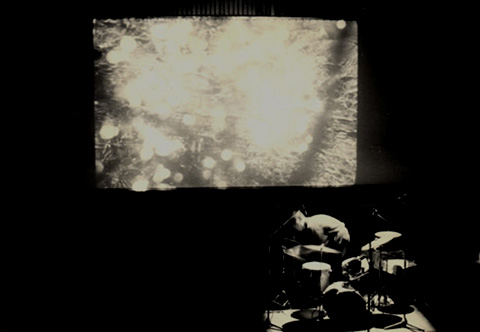
WATERWAYS (83)
"Waterways" was premiered in June of 1983 at the Experimental Intermedia Foundation in New York. The work is a kind of elegy for a brook that flowed near the house where I grew up. I spent several days documenting the brook with my camera and my cassette deck. There were two things that stood out on the tapes. The first was the sound of a single drop of spring water falling from the hanging moss onto a stone. The second was the recording of water rushing over the rocks, so full of detailed running melodies. I later filtered and isolated pitches from these two sources and slowed them down so that their tuning was in the same range as my drum set. I mostly used the single drop of water layered many times; in essence, I reconstituted a flowing stream of water. In the first version of the work I played the tape through small speakers placed inside the drums. This worked better as an idea than as a reality. The original performance also included a multiple slide projection of the photographs I had taken. I later edited the tape down to its current length and scored the acoustic music for concert percussion. This version released on the CD “Electro-Acoustic Solo Works” uses marimba, vibraphone, steel drums, timpani, cymbals and some small bells along with tape. There is also a video version of the work.
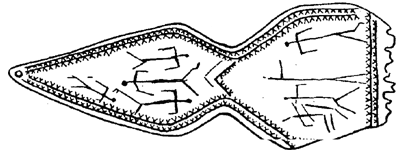
AIVILIK RAYS (90)
"Aivilik Rays" was first premiered as a concert length work in March of 1988 for tape and both acoustic and processed percussion. The work employed a theatrical approach unfolding in performance in a cinematic matter. The work was inspired by the Arctic landscape; it's people and the peculiar history of the outside world's confrontation and manipulation of its unique character. The concrète material on the tape is derived from both related environmental sounds such as wind, ice and birds, and also some particularly quiet percussion sounds. This material was processed and mixed with sound generated on a Serge Modular Music System analog synthesizer. The acoustic percussion was processed on a LXP-5 via transducers placed directly on the drums and percussion. I controlled levels with a mixer and foot pedal volume control. Barry Lopez' book "Arctic Dreams" sparked my interest in this area of the world. Further research led me to the writings about the Aivilik Eskimo by Edmund Snow Carpenter, an anthropologist who spent time with the Aivilik in the 1950's. From his book "Eskimo" (Univ. of Toronto Press, 1959) comes this observation. "The Aivilik Eskimo defines space more by sound than sight. Where we might say 'Let's see what we can hear.' they would say, 'Let's hear what we can see.'"
The piece is divided into four sections, which flow one into the other.
I Invisible Markers
II The Art of Survival
III Migrations
IV Lost Frontier
The first section refers to the way in which the Aivilik negotiate their surroundings. Imagine standing on the frozen terrain, surrounded completely by flat ice. When the sun is out, it sets and rises in a different place each day. At one point in the year the sun does not set at all but instead travels in a circle just above the horizon. Every direction you look at the landscape looks the same. All of our navigational skills are useless in this part of the world. The Aivilik can see subtle markers not visible to us. They smell the wind and listen carefully to how it sounds to judge the direction of their travel.
The second section references the way in which the Aivilik have shaped their existence with an intuitive understanding and respect for the animals on which they depend for survival. Imagine the stillness of a hunter perched with a spear over a hole in the ice, waiting for hours for a seal to choose his hole to take a breath. In the third section the subject is arctic migration patterns. What fascinates me is how some animals do not appear to follow a pattern we can recognize. The musk ox for instance, migrates in a non-cyclical way, never returning to the same area, or latitude in relation to the year cycle. So much in our temperate zone lifestyle is about patterns that repeat. Even in music, forms that cycle or recapitulate always seem to feel more familiar.
The fourth section laments the slow and steady plundering of our last frontier. It is painful to realize that an essential ecosystem and culture is decaying from a senseless lack of foresight.
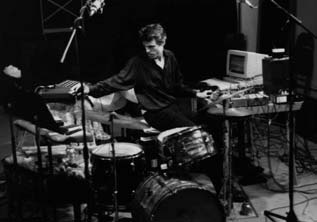
POLAR
“Polar” was originally performed as a quadraphonic mobile sound architecture, constructed from sampled sound and controlled in real time. It was premiered at Roulette in May of 1990. I grouped my sound materials into pairs of poetic opposites such as, Gunfire/Lullabies, Fire/Water, and Consonant/Vowel. Instead of tape this time I used the Akai Sampler and a computer to develop the material. I then sequenced the pairs of material, each half of the pair on a separate track and later overlapped the sections to create one continuous piece. This left me with the midi equivalent of two mono, synchronized tapes, each of which had one side of the pairs. In the quadraphonic version I controlled the processing and panning of each tape separately. This meant one track was panned by adjusting controls on a Serge Quad Panner, which attenuated the speed and shape of the pan. For the other track I used a graphic tablet, a kind of joystick, which meant that I could manually move the sound in space wherever I wanted. The work was reworked into a stereo setting for release on the “Electro-Acoustic Solo Works” on Random Acoustics Recordings.additional collabrations with :
Claudia Herbst, Filmmaker
ATCG Soundtrack/Collaboration for Film (5/00)